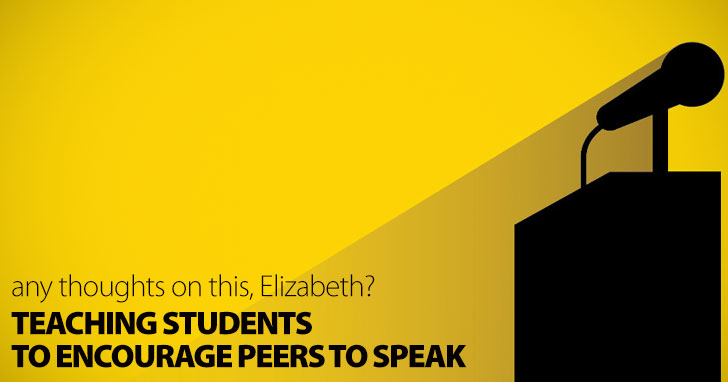Any Thoughts on This, Elizabeth? Teaching Students to Encourage Peers to Speak


There is usually just one of these students per class, and usually such students are very pleasant, articulate, and intelligent. However, they do tend to dominate the discussion. And the very niceness these students usually also have becomes something of a problem here as the instructor does not want to offend, hurt feelings, or discourage the student from participating. She just wants the student to, well—share the floor.

As a starting point, the student who dominates the class discussion is often just unaware of her behavior and its sometimes negative effects. She may in fact think she is being a good student by participating.
The most common and obvious reason for students to dominate the conversation is simply personality style. The student, by nature or training, is more comfortable speaking up than his peers. He therefore is quicker to speak and has skill in spotting opportunities to enter the conversation and gain the floor as well as retain it.
Another reason students dominate the discussion is insecurity. In an effort to mask sagging self-worth, students may seek the attention and control that comes from dominating the discussion.
The student may also dominate the conversation in an effort to win teacher approval. Talking does get you noticed, and the student may think that the attention that comes from controlling the conversation will be positive—after all, in high school and lower grades, students are in fact often awarded for “participation.”
College teachers often come to the field as subject-matter experts, not experts in classroom control. They assume that adults will conduct themselves appropriately, and when students don’t, the teacher doesn’t know what to do as she may have little or no training in correcting students on their behavior.
Similarly, other students may be reticent about correcting a peer’s behavior. They may be embarrassed by the peer’s behavior and uncomfortable about speaking up. They may not feel it is their “place” to speak up.

A monologue is not a dialogue. With only one student doing all or most of the talking, the discussion is not advanced with contributions from varying points of view as is expected in academic discourse.
Ironically—or perhaps as is expected—the most talkative of students are not necessarily most insightful and analytical. If they have done little listening to others in class or elsewhere, their perspectives may not be very broad.
When one student seizes control of the class discussion, she also has in many ways hijacked the curriculum as well. At minimum, the viewpoints of other students are not being included, and often addressing multiple points of view is an explicit part of the course curriculum. At worst, critical course topics may be neglected or forgotten as Mr. Chatterbox rambles on.
When the dialogue disintegrates from dialogue to monologue from one student, other students’ ideas and comments are suppressed, creating oppressed feelings among students. This in turn creates a negative class atmosphere that can be difficult or impossible to recover from.
There are a number of reasons teachers and students may choose not to speak up about the students who dominates the discussion. However, teachers do have an obligation to speak up so that everyone has a chance to participate and to limit the negative effects of the dominating party. Following are some strategies to give everyone in class a chance to speak and keep the dialogue truly a dialogue and not a monologue.

Being usually proactive goes a long way, and if the instructor from the first day of class addresses expectations regarding class discussion, participating, and listening to peers, there is less chance the conversation will be taken over by Ms. Loquacious. In addition, if this expectation is reinforced throughout the term, to the class as a whole, the offending student is not (explicitly, anyway) singled out.
When possible, without interrupting Mr. Talkative, ask explicitly for other students’ participation. Perhaps you have just put out a general question; you may say something such as “Let’s hear from the back of the room this time” (or the right side, etc., wherever Ms. Chatterbox is not sitting). This reminds both Mr. Talkative and the class as a whole that “group discussion” is really a class endeavor.
Again, when possible, find a break in the monologue to insert “Those are such great thoughts, Brett, but let’s hear from some other students—Stephanie has had her hand up for awhile.” This accomplishes several things: it reminds Brett that other students are present with their own viewpoints; it reinforces the expectation for the entire class that the discussion requires engagement from all, and it recognizes the student who has been polite in raising her hand.
If the problem is pervasive enough, with one or a couple of students dominating each conversation, you may resort to asking students to raise their hands to be recognized before speaking. This is not my preferred method as it tends to disrupt the flow of ideas and seems contrary to the classroom of adults, who should know how to not interrupt each other, but it is a good temporary fix in limiting the behavior of those who dominate the discussion. It also gets students in the habit of thinking and waiting before speaking, something they often don’t do with more relaxed rules.
Often the behavior of the talkative student is minimized in a smaller group. The other students are forced to participate more in a smaller group, for example, as hiding out in the back of the room is no longer possible. The behavior of the domineering student becomes heightened and less appropriate in a smaller group, and the other students may be less tolerant about one individual taking over the discussion. If groups are changed up each course session as well, this doesn’t allow new group dynamics to form with Ms. Talkative again at its center.
There are a number of reasons for a student to dominate class discussion, and he may not even be aware that he is doing it. However, there are also methods to limit the effects of a chatterbox in the class and keep the discussion a truly class discussion.